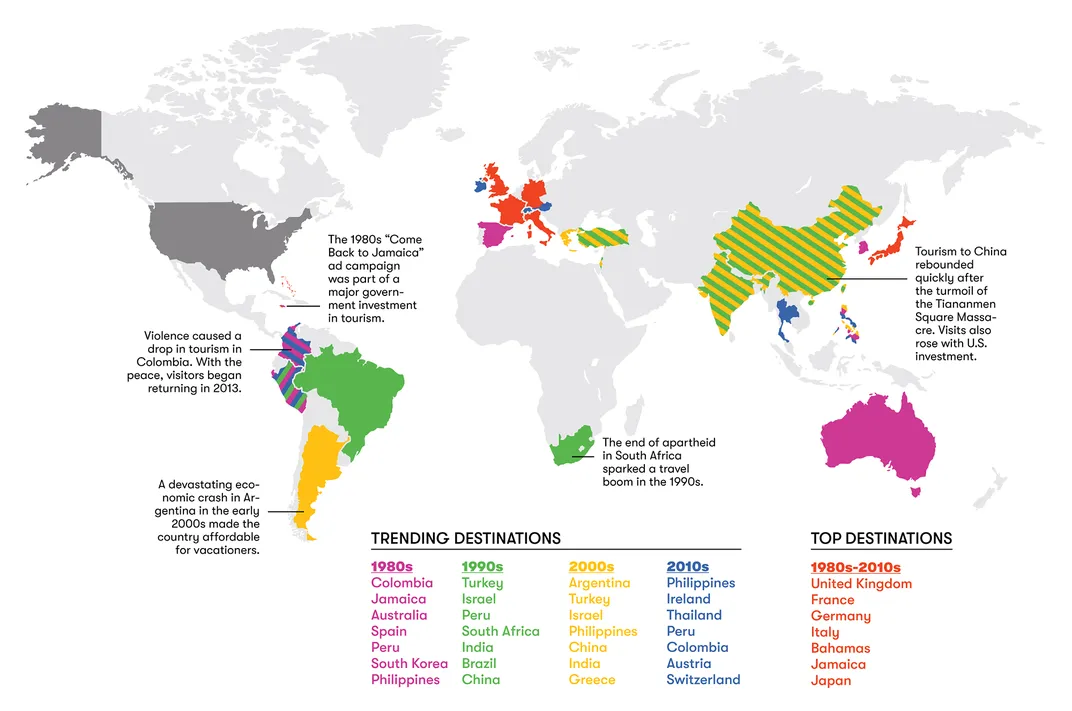Traveling the World Was Never the Same Once the Boeing 747 Debuted
Wave goodbye to the beloved jet that took us to new heights
:focal(3696x1653:3697x1654)/https://tf-cmsv2-smithsonianmag-media.s3.amazonaws.com/filer/8b/a5/8ba51cac-cf0b-4baa-96c4-bbec14a8d813/oct018_a14_prologue.jpg)
When the first Boeing 747 rolled from the hangar in Everett, Washington, 50 years ago, onlookers were stunned. The aircraft before them, gleaming in the morning sunshine, was more than double the size and weight of any existing jetliner. An airplane of firsts and superlatives, the 747 owed its instant fame mostly to feats of size. It was the first jetliner with two aisles—two floors, even!—and enormous as it was, the 747 had gone from a literal back-of-a-napkin drawing to a fully functional aircraft in just over two years, an astonishing achievement.
A decade earlier Boeing’s 707 had ushered in the Jet Age, but with four fuel-thirsty engines and room for fewer than 200 passengers, fares were beyond the budget of most vacationers. The 747 introduced economies of scale that, for the first time, allowed millions of people to travel nonstop over great distances. It changed global air travel forever.
And it did so with a style and panache that we seldom see in aircraft design. The “Father of the 747,” Boeing engineer Joe Sutter, and his team, built an airplane that wasn’t just colossal, but also downright beautiful. “Most architects who design skyscrapers focus on two aesthetic problems,” the architecture critic Paul Goldberger once wrote. “How to meet the ground and how to meet the sky—the bottom and the top, in other words.” What is a jetliner to the eye but a horizontal skyscraper, its beauty created (or squandered) primarily through the sculpting of the nose and tail? Sutter understood this perfectly. The 747’s most distinctive feature, the upper deck, has inspired descriptions like “bubble-topped” or “humpbacked,” which couldn’t be more mistaken. The deck’s design is smoothly integrated into the rest of the fuselage, tapering rearward from the cockpit windscreen to form an assertive, almost regal-looking prow. Two hundred feet behind, the jet’s six-story tail evokes the rakishly canted sail of a tall ship. Even the name itself is such a neat little snippet of palindromic poetry.

This is the aircraft that carried every president for almost three decades under the call sign Air Force One. It carried the space shuttle. And it was the star of any number of Hollywood disaster movies. (Who can forget Charlton Heston and Karen Black in Airport 1975?) We should mention its roles in real-life tragedies, too, from the collision at Tenerife to the explosion of TWA Flight 800. The photograph of the wreckage of Pan Am’s Maid of the Seas lying sideways in the grass at Lockerbie is among the most indelible images in aviation history.
In my 28 years as a commercial pilot I have never flown a 747, but I will always remember my first time on one in 1982. I vividly recall stepping into the entryway vestibule and glimpsing the famous spiral staircase that led to the upper deck. Seven years later, I was a passenger on the inaugural 747-400 flight from New York to Tokyo. Everyone onboard was given a commemorative sake cup. I still have mine.
The numbers that made good commercial sense for airline businesses in 1968, though, are no longer in the 747’s favor. One by one, the world’s major carriers have been sending them to the boneyard, and for the first time in almost 50 years, no U.S. carrier flies passengers on a 747. When Delta Air Lines retired the last of its fleet earlier this year, the plane took a cross-country farewell tour, including a stop at the Washington factory where it was manufactured. The 747-8, the largest and most modern 747 variant, has sold only sporadically and production has dwindled to almost nothing—though Boeing is prepping two for duty as the next Air Force One—and the assembly line is bound to go dark soon. The fragmentation of long-distance air routes, along with the unbeatable economics of newer aircraft models, have finally dethroned the “Queen of the Skies.”
At the same time, reports of the plane’s death have been greatly exaggerated. Hundreds remain in service worldwide. British Airways, Lufthansa and Korean Air have dozens apiece, and many more airlines operate 747s as freighters. They’ll be crossing oceans for years to come.
Like other American emblems of design and commerce, from the Empire State Building to the Golden Gate Bridge, the 747 endures—a little past its prime, sure, but undiminished in memory and in its power to inspire and awe. It has carried tens of millions of people to every corner of the globe, an ambassador of our technological know-how and imagination at its best. It could be a metaphor for America itself: No longer the most acclaimed or the flashiest, it remains unmistakable and graceful in ways you might not expect. And in spite of any proclamations of its demise, it carries on.
Frequent Fliers
From Colombia to Thailand, the hot spots for Americans heading overseas are always changing
Does it seem as if everyone in your Facebook feed is climbing Machu Picchu? It’s not your imagination. Peru has been among the fastest-growing overseas destinations (a term that excludes Mexico and Canada) for American travelers for decades, on track to overtake the United Kingdom, annually the top in number of visits, by 2041, a Smithsonian analysis found. Here’s a look at how our travel habits have changed—and the forces that influence our choices.
By Austin Clemens
